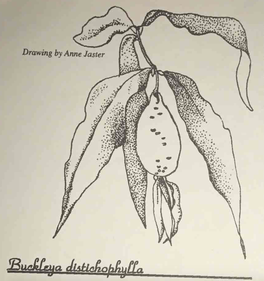We thought you’d enjoy this article, originally published in the Fall 1990 issue of The Newsletter, because it features just one of the many unique features of the Landis Arboretum. It was written by Director Pamela Rowling.
The accompanying drawing is by long-time member and supporter, Anne Jaster.

Sandalwood, aromatic and sweet smelling, is perhaps the best known member of the predominantly tropical plant family Santalaceae. Uncommon in temperate regions, this group is represented in the growing collections of the George Landis Arboretum by Buckleya distichophylla. Buckleya is named in honor of S. B. Buckley, American botanist who lived from 1809 to 1884.
This genus encompasses five species. B. distochophylla is spring green, deciduous and bears its slender leaves opposite along slender arching stems. The plant is said to reach an eventual height of 12 feet; however, old specimens at the garden have only attained 6-7 feet in height. Plants are dioecious: the flowers of both sexes are green and inconspicuous. Female blooms are solitary, while the male flowers are smaller and borne in terminal umbels.
A fascinating characteristic of Buckleya is that it is a “root only” parasite and must be grown in close proximity to its host plant Tsuga (hemlock). The maturing ovary forms a green drupe, peculiar in its characteristic of allowing only one ovule to develop and that this resultant seed lacks a seed coat. Buckleya is propagated by seed which, as previously mentioned, must be grown near a hemlock. In our limited experience, the association does not severely hamper the host plant.
Our specimens are found growing in the flat area just above the Quarry Rock Garden. A two-foot specimen was recently spotted growing as a volunteer in the woodland area by the Meeting House. Buckleya is grown in collections primarily as a novelty: its light, open appearance and “Granny Smith apple green” leaf color make it quite appealing. Its ability to grow in relatively deep shade heightens the color contrast of its foliage.
Look for this plant on your next Arboretum visit.
